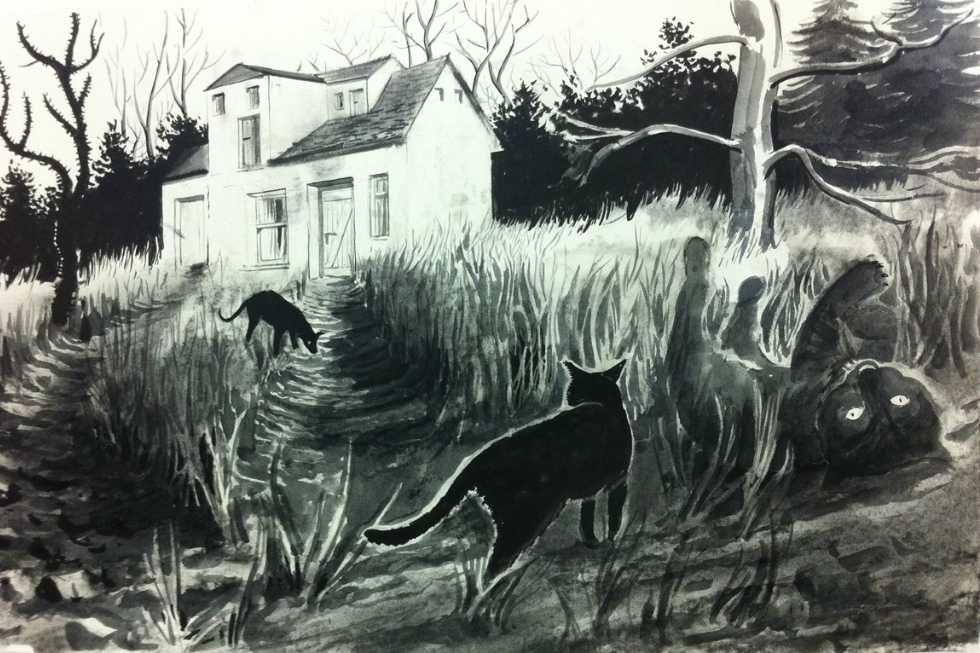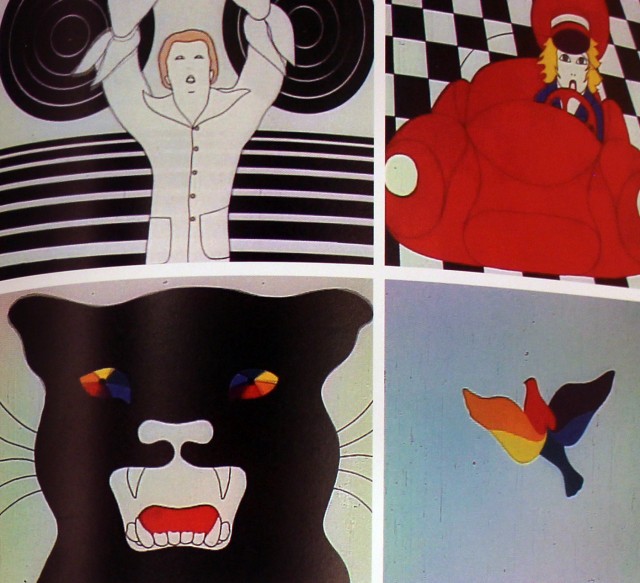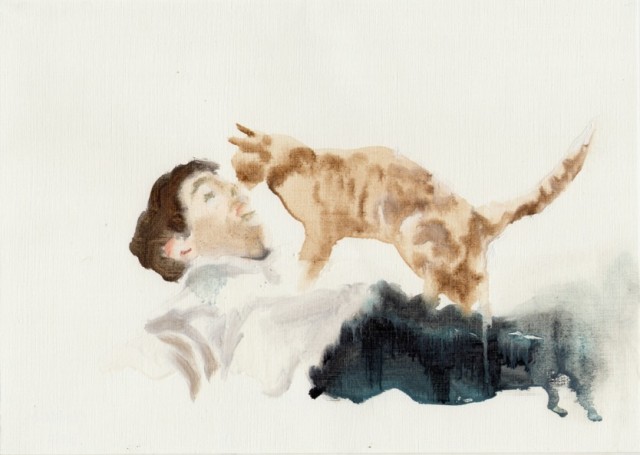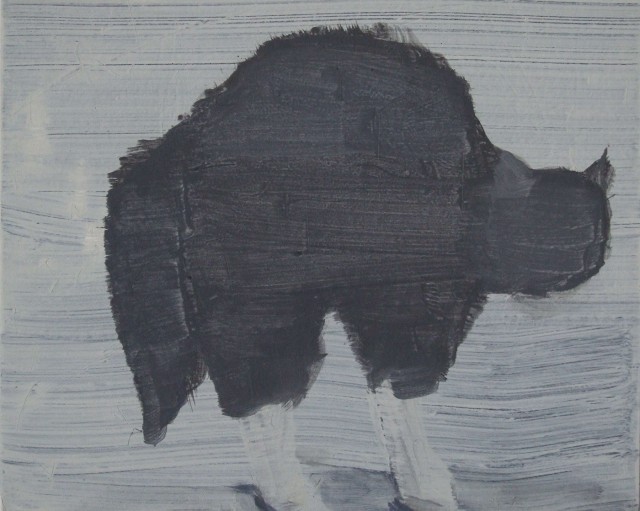Meow! PAPER Gallery Goes Mad For Cats

Celebrity cats, lost cats, playful cats, dead cats: Sara Jaspan speaks to the artists behind a purrrrfect (sorry) exhibition of feline portraits…
Perhaps since they were first domesticated, then venerated, by the Ancient Egyptians over 4,000 years ago, cats have occupied a unique place in human society and culture. Their often rather aloof temperament does nothing to temper our fixation (quite the opposite); in our Internet age, their appeal seems stronger than ever before (hello, Lil Bub). The current exhibition at PAPER Gallery, called The Cat Show, takes this viral fandom as its point of departure, inviting artists to respond to the feline theme in whatever way they choose. The results have been diverse: surreal, touching, funny, gritty, biographic — even sexual.
We spoke to artist and PAPER Gallery Director, David Hancock, plus exhibiting artists Cathy Lomax (Film Cats (2016)) and Miho Sato (Untitled series (2016)) about the brief, and the subject’s universal appeal…
The Double Negative: Hi David. Firstly, may we ask what first prompted the idea of an exhibition dedicated to cats?
David Hancock: It originally began as a light-hearted suggestion for our Christmas show at PAPER. When we started approaching artists, however, we were enthused by their response and found many were keen to make work on the theme. We originally offered the idea to our gallery artists, then issued an open call on a-n News, and began directly approaching several more established artists who had previously made work about cats.
What did you find most interesting about the responses you received? Is there anything you were surprised by?
The response was incredibly diverse. The works covered a variety of media including print, animation, collage, drawing, painting, and photography. Established artists like Miho Sato, Brian Reed, Cathy Lomax and Narbi Price were all keen to take part. The opportunity also initiated collaborations with other galleries, such as Galerie Kleindienst (Leipzig, Germany) that sent us an amazing work from Tilo Baumgärtel [main picture], and Avangard Gallery (Pärnu, Estonia) from which we loaned a 1974 film animation by Leonhard Lapin [pictured, below] and a new lino-cut on paper by Peeter Allik.

Are there any shared or re-occurring themes that you’ve noticed within The Cat Show?
There are a few pieces looking at lost cats, such as Brian Reed’s colourful laser-print Lost, and David Miles’ Felix, a work he made after undertaking a residency in Montreal during which he collected lost cat posters. I think the idea of a lost cat is quite tragic, particularly that sense of not knowing. As a cat owner, I think it would be my biggest fear.
There’s also several works that don’t actually feature cats, but instead look at their presence within our lives. In my own contribution to the exhibition, I focussed instead on my cats’ toys and their relationship to them: the fact that they are mauled, chewed, licked and loved.
Also, a number of artists chose to make work around celebrity cats, from Narbi Price’s portrayal of Frisky (the Coronation Street cat) to Cathy Lomax’s Film Cats, a series of paintings which depict cats taken from famous films.
Finally, we have a few works that are epitaphs to deceased cats, such as Sarah Jeffries’ Pepsi and Puma and Simon Woolham’s The Shed (Boo Boo). Each of the cats represented in the show has a distinct personality and through their representation, The Cat Show is clearly an exhibition of portraits.
Are you a cat person? Why do you think cats hold such popular appeal?
I have four cats, three of which are named after famous artists: Frida, Max, and Pablo. We’ve also been posting daily cat videos on our Facebook page as an online accompaniment to the exhibition and nod towards the viral online culture that has strangely grown up around cats.

Do you feel the show makes any comment on where we are now, in terms of society and culture?
We programmed the show in 2015, but it now seems especially apt after the shitty year we’ve had. It’s very difficult to find something positive at present but I think a love of cats is pretty universal, and we need a little bit of universalism right now. The show re-enforces that there is a desire in us to be diverted, and so something that initially appears quite frivolous can reveal a deeper resonance.
Cathy Lomax, congratulations on the exhibition and the new work you’ve created for it — a delicate series of five watercolour paintings entitled Film Cats [pictured, above]. How did you approach The Cat Show brief?
Part of my practice includes collecting images from films that I watch and then ordering these by the date I saw them and into different thematic categories. I use these images as source materials for my paintings, such as in my ongoing painting series Film Diary, which began in 2009. One of my thematic categories is cats. So, when David first approached me to take part in the show, I turned to my archive and selected five images to paint. Each work was created without much attention to the films from which the cats were lifted (which, incidentally, are: The Long Goodbye, La Bete Humane, Portrait of a Lady, Bright Star and, of course, Cat People) but simply looking at the aesthetic qualities of the image.

The cats I selected are all shown locked in moments of interaction with people: either being stroked or lifted. They are also demanding: one waking his adopted owner (It woke him up because it was hungry [pictured]), another objecting to a book being read (She was trying to read). My cats are all different breeds and each have their own distinct personalities. They are natural non-actors, just doing their own thing – an attitude that somehow tends to draw a more natural performance out of the humans around them.
And Miho Sato: why The Cat Show? And how do your ghostly images of shapes, animals and people sit in relation to the new works [pictured, above] you’ve produced here?
I first met David Hancock when I took part in an exhibition he co-curated with Richard Meaghan for the Liverpool Biennial Independents in 2004, called Le Petit Paysage. It was a great experience so I was keen to work with him again when he invited me to take part in The Cat Show. I also found the theme he’d chosen very interesting. Though I often use both wild and domestic animal imagery in my work, I’ve never painted cats before and was concerned that the outcome might become too pretty – it therefore presented a challenge.
The experience of taking part reminded me of when you first start out as an art foundation student and everyone is set the same exercises to respond to, yet everyone responds differently. After graduating, it can be hard to keep things fresh – I try not to repeat ideas or practices but it can be hard – therefore having this externally set brief was a really useful and interesting exercise.
Sara Jaspan
See The Cat Show at PAPER Gallery, Mirabel Street, Manchester, until 17 December 2016 — FREE
See the full portfolios of Cathy Lomax and Miho Sato on their websites
Images, from top: Tilo Baumgärtel, Untitled (Cats), 2011. Leonhard Lapin, A Coloured Bird, 1974. Cathy Lomax, It woke him up because it was hungry (The Long Goodbye), 2016. Miho Sato, Untitled (Cat #1), 2016. All part of The Cat Show, PAPER Gallery 2016





